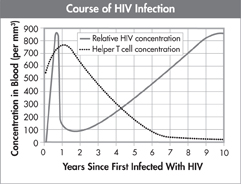Standardized Test Prep
Multiple Choice
All of the following prevent pathogens from entering the human body EXCEPT
red blood cells.
tears.
mucus.
skin.
Which of the following is NOT part of the inflammatory response?
White blood cells rush to infected tissues.
Blood vessels near the wound shrink.
Phagocytes engulf and destroy pathogens.
The wound becomes red.
What is the role of a vector in the spread of disease?
A vector is an inanimate object, such as a doorknob, where pathogens may collect.
A vector must infect a host for its life cycle to continue.
Vectors usually do not suffer from the infection, they just spread it from host to host.
A vector is a pathogen.
Which type of lymphocyte produces antibodies that are released into the bloodstream?
cytotoxic T cells
helper T cells
phagocytes
plasma cells
Which of the following is NOT a white blood cell?
interferon
macrophage
cytotoxic T cell
lymphocyte
Which is an example of naturally occurring passive immunity?
vaccination
exposure to a disease
an infant consuming antibodies in breast milk
antibodies are injected from another person
How do medications help a person with asthma?
Antihistamines counteract the effects of histamines.
They suppress the immune system.
They increase mucus production in the lungs.
They relax smooth muscles around airways.
Questions 8–9
A researcher measured the concentrations of HIV and T cells in 120 HIV-infected patients over a period of 10 years. Her data are summarized in the graph.
What happened to the HIV concentration over years 2 through 9?
It stayed about the same, then suddenly increased.
It stayed about the same, then suddenly decreased.
It steadily increased.
It steadily decreased.
What is probably responsible for the change in HIV concentration during the first year?
immune response
inflammatory response
passive immunity
HIV stopped replicating
Open-Ended Response
Explain why some symptoms of disease such as coughing and sneezing are advantageous to the pathogen that causes the disease.
| Question | 1 | 2 | 3 | 4 | 5 | 6 | 7 | 8 | 9 | 10 |
|---|---|---|---|---|---|---|---|---|---|---|
| See Lesson | 35.2 | 35.2 | 35.1 | 35.2 | 35.2 | 35.3 | 35.4 | 35.4 | 35.4 | 35.1 |
Table of Contents
- Formulas and Equations
- Applying Formulas and Equations
- Mean, Median, and Mode
- Estimation
- Using Measurements in Calculations
- Effects of Measurement Errors
- Accuracy
- Precision
- Comparing Accuracy and Precision
- Significant Figures
- Calculating With Significant Figures
- Scientific Notation
- Calculating With Scientific Notation
- Dimensional Analysis
- Applying Dimensional Analysis





